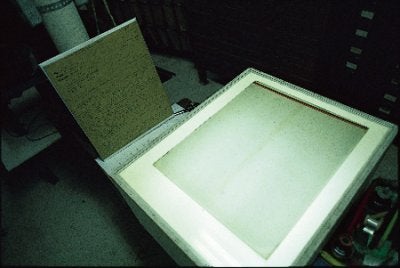There are more than three million slowly deteriorating photographic plates recorded over a century and a half at many small observatories around the world. With today’s digital revolution in full swing, it would be easy to forget the huge wealth of data recorded by early observers using photographic plates. Each plate represents a unique record of the universe from a time past that can never be repeated.
The Pisgah Astronomical Research Institute (PARI) in North Carolina has proposed a plan to ensure the safety of the astronomical photographic collections in North America and to digitize each plate for future generations to use.
The first step is to establish a list of priorities for United States collections at risk. The project was described at the 205th meeting of the American Astronomical Society in San Diego in January.
“The photographic records are in serious jeopardy and a call to the international community to safeguard this priceless wealth of photographic data, some dating back over a century, has been made,” said Michael Castelaz, Director of Astronomical Studies and Education at PARI. “It’s a unique legacy left by previous generations of astronomers.”
Ten years ago the International Astronomical Union (IAU) began asking the question about what to do with the huge collections of plates around the country. Large observatories, such as Mt. Wilson, have been taking steps to preserve nationally recognized collections of plates, including some of Edwin Hubble’s earliest images of galaxies. But small university research observatories don’t have the space or the resources to store and archive thousands of plates.
In 1992 the IAU formed a working group to archive all spectroscopic data.
“It’s very much a vision to be realized,” said Elizabeth Griffin, Chair of the IAU Working Group on the Preservation and Digitization of Photographic plates, based at the Dominion Astrophysical Observatory (DAO) in Canada.
“The thre- year plan of the current project begins with an inventory of collections and learning what is out there,” said Castelatz. “Then we’ll establish a preservation and digitizing scheme for the plate.”
The first plate collection has already arrived at PARI — 2,200 objective prism plates from the University of Michigan.
Once the “at risk” plates are safely stored, the long-term process of digitizing plates will take place. The cost of the project, including salary for an archivist and the costs for shipping and handling of delicate photographic plates, is about $100,000 a year. Funding sources are being sought.
Why is this preservation so important? Elizabeth Griffin explains, “I cannot go back a hundred years and take that data again. If there’s a supernova somewhere, the clues to identifying which star went supernova might be hidden on one of these plates. They’re time capsules of the sky, snapshots of a time that cannot be returned to.”
If this (digitizing) is not done, over 100 years of data with great potential to assist astrophysical research will be lost.
Michael Castelatz adds an interesting comparison for our digital generation. “Not archiving the vast array of photographic plates would be like throwing away the Hubble Space Telescope archive once its mission is done.”
A special session is planned at the January 2006 meeting of the American Astronomical Society in Washington, DC. For more information, visit the PARI site.










